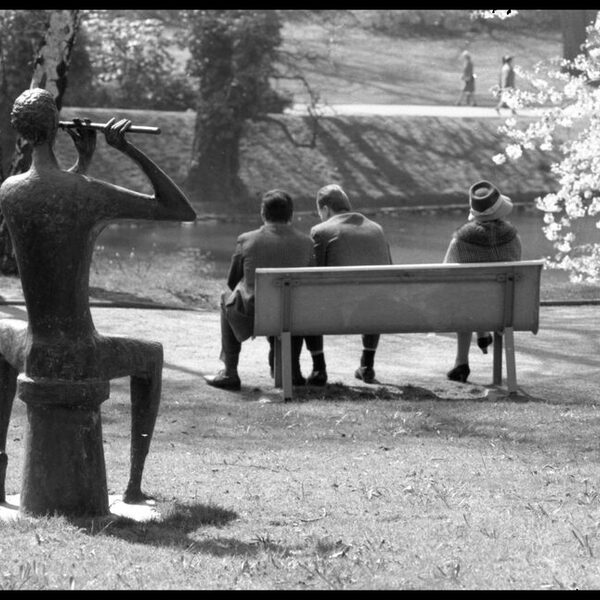Art in public space
The Hygieia group, originally erected near the Kochbrunnen fountain in 1850, is considered the earliest example of art in public spaces in Wiesbaden. The sculpture of a female figure drawing water, which Arnold Hensler created in 1932 for the Reisinger and Herbert grounds at the main railway station, was the first autonomous work of art to be created for Wiesbaden's public spaces without any mythological or historical reference.
The term art in public spaces not only includes artistic projects in urban outdoor spaces, but also art in buildings and associated facilities. The "Art in Construction" law passed in 1950 stipulated that 2% of the construction sum should be spent on art in federal construction projects and later also at state and municipal level (Directive K7). According to the theoretical approach, works of art should serve to embellish architecture and urban life or appeal to the population in the form of memorials and monuments, as a contribution to discussion, as a "brightener". The 1955 "Horse" by Stuttgart sculptor Fritz von Graevenitz in front of the Federal Statistical Office was the first work of art to find its way into the Wiesbaden public sphere in this way. Art in public spaces emancipated itself towards the end of the 1950s, particularly through its abstract formal language. According to a slogan of the 1960s, art should leave the space reserved for it in museums and meet the public where they are: on streets, squares and in parks. A beautiful work from this period is the sculpture "Fanal der Jugend" (Beacon of Youth) by Egon Altdorf, which was erected in 1962 at the Gymnasium am Mosbacher Berg. This free-standing sculpture was a novelty in German sculpture in terms of the material used, copper, and its formal language was exemplary of German sculpture, which was just catching up with international developments.
In the following years, art in public spaces increasingly lost its independence and occasionally only served to embellish an increasingly monotonous architecture. The abstract visual language could no longer be deciphered by the untrained observer. One example of this is Otto Herbert Hajek's "Raumzeichen mit Platzartikulation" from 1976, a stainless steel sculpture erected in the inner courtyard of the Biebrich Galatea complex, which takes up the hexagonal layout of the square architecture and attempts to accentuate a center, but appears just as cool and unapproachable as the square itself.
Since the 1960s, however, there has been a gradual realization that art can do more than just decorate insignificant architecture. As a result, contemporary art overcame its lack of context or place. Artists endeavored to incorporate the surrounding space and its particularities into the creation of the work in order to achieve a new experience of work and place. For example, Wolf Spitzer's large sculpture "Communication", erected in 1987 in front of the former Wiesbaden telecommunications office on Konrad-Adenauer-Ring, symbolically visualizes the exchange of information.
In the 1980s, art in public spaces was significantly influenced by an expansion of the concept of art. According to Joseph Beuys, people became artists through their actions, shaping their environment and society. A basalt stone from Beuys' best-known art project "7000 Oaks" at documenta 7 in Kassel was brought to Wiesbaden thanks to the dedicated efforts of an art class at the Martin Niemöller School. Gabriel Seixas' sculpture "Ecological Balance" from 1999 in the Nassauische Sparkasse service center at Karl-Bosch-Straße 19 stands for politically committed art: the Portuguese sculptor placed a dome-shaped block of carved marble on a thin stainless steel rod in such a way that it appears to float in perfect balance. However, if you touch the stone, it immediately starts to vibrate and could - so the idea goes - easily lose its balance.
While art in public spaces was previously aimed more at passive viewers, towards the end of the 20th century they were increasingly asked to take an active role. For example, any citizen can apply to set up their own exhibition as a curator in the "smallest museum in the world" on the Freudenberg. The only condition is that the objects must be small enough to fit into the existing presentation boxes/boxes, as the art on Butterblumenweg can only be viewed from the outside through peepholes.
In order to make art in public spaces exciting and meaningful for laypeople, it must correspond to everyone's world of experience. An exciting example is the installation "Heavy Luggage" by artist Andreas von Weizsäcker on the station forecourt, realized in 2006. The cast-iron suitcase impressions appeal to passers-by in a variety of ways. Associations of farewell, longing for faraway places, but also memories of the dangers of abandoned luggage in public places are evoked - contemporary art in public spaces thus becomes a mirror of one's own experiences.
Literature
Space.Art. Skulptur in Wiesbaden seit 1955. Kunstbetrachtungen, Kulturamt der Landeshauptstadt Wiesbaden (ed.), Wiesbaden 2002.
